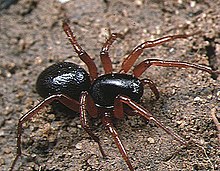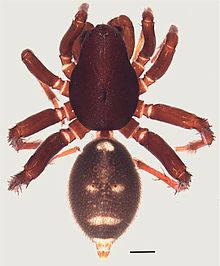Ant spider: Difference between revisions
Content deleted Content added
Rescuing 3 sources and tagging 0 as dead. #IABot (v1.4) |
Updating genus name of Colima in accordance with Jocqué & Baehr, 2021 |
||
| (25 intermediate revisions by 16 users not shown) | |||
| Line 1: | Line 1: | ||
{{Short description|Family of spiders}} |
|||
{{More refs|date=April 2017}} |
|||
{{ |
{{Automatic taxobox |
||
| fossil_range={{Fossil range|Palaeogene|present}} |
|||
| name |
| name=Ant spiders |
||
| image = Mallinella.fulvipes.female.-.tanikawa.jpg |
|||
| |
| image=Mallinella.fulvipes.female.-.tanikawa.jpg |
||
| image_caption=Female ''[[Mallinella fulvipes]]'' |
|||
| display_parents |
| display_parents=2 |
||
| taxon |
| taxon=Zodariidae |
||
| authority |
| authority=[[Tord Tamerlan Teodor Thorell|Thorell]], 1881<ref name=WSC_gl109/> |
||
| diversity_link = List of Zodariidae species |
|||
| |
| diversity_link=List of Zodariidae species |
||
| diversity=90 genera, 1259 species |
|||
| diversity_ref |
| diversity_ref=<ref name=WSC_stats/> |
||
| range_map |
| range_map=Distribution.zodariidae.1.png |
||
| subdivision_ranks = Genera |
|||
| subdivision = See text. |
|||
}} |
}} |
||
[[File:Palindroma morogorom paratype male dorsal.jpg|thumb|Male ''[[Palindroma morogorom]]'']] |
|||
| ⚫ | |||
'''Ant spiders''' are members of the [[family (biology)|family]] '''Zodariidae'''. They are small to medium-sized eight-eyed [[spider]]s found in all tropical and subtropical regions of South America, Africa, Madagascar, Australia-New Guinea, New Zealand, Arabia and the Indian subcontinent.<ref name=":0">{{Cite web|url=http://www.arachne.org.au/01_cms/details.asp?ID=1664|title=Zodariidae ant spiders|access-date=2019-11-02}}</ref> Most species are daytime hunters and live together with ants, [[mimicking]] their behavior and sometimes even their chemical traits.<ref name=":0" /> Although little is known about most zodariids, members of the genus ''[[Zodarion]]'' apparently feed only on ants; a number of other [[genera]] in the family are apparently also [[ant]] (or [[termite]]) specialists.<ref>{{Cite web|url=https://eol.org/pages/9038/articles|title=zodariid ground spiders|website=EOL-Encyclopedia of Life|access-date=2019-11-02}}</ref> |
|||
[[Image:Mallinella.fulvipes.male.-.tanikawa.jpg|thumb|right|250px|male ''[[Mallinella fulvipes]]'']] |
|||
| ⚫ | |||
| ⚫ | |||
'''Ant spiders''' are members of the [[Family (biology)|family]] '''Zodariidae'''. They are small to medium-sized eight-eyed [[spider]]s found world-wide in tropical to warm temperate regions, though there are relatively few species in [[North America]]. |
|||
| ⚫ | |||
Some zodariids are [[ant mimicry|ant mimics]]. Although ant mimicry is quite common in spiders, the form it takes in the zodariids is unusual because, although each species bears a morphological resemblance to the species of ant that forms its prey, the resemblance is not particularly close. It is enhanced by the spider's behaviour. The spiders live in association with a nest of ants of their prey species, and use their mimicry to enter and leave the nest unmolested (if the ants detected them as intruders they would mass to repel and perhaps kill them). The spiders walk on only the three rear pairs of legs, and if they encounter an ant during their forays into the nest territory, they touch their front legs to the ant's antennae in the same way as another ant would with its own antennae. If they have already captured an ant, they then offer that towards the challenging ant, which inspects it and behaves towards the spider as if it were another ant carrying a dead conspecific away from the nest (a common behaviour among ants). |
|||
It is likely that the spiders also derive some protection against predation from their similarity to the ants, since ants are unpalatable to many species that eat spiders. |
|||
| ⚫ | |||
| ⚫ | |||
{{Div col|colwidth=25em}} |
{{Div col|colwidth=25em}} |
||
*''[[Acanthinozodium]]'' <small>Denis, 1966</small> |
*''[[Acanthinozodium]]'' <small>Denis, 1966</small> |
||
| Line 38: | Line 32: | ||
*''[[Basasteron]]'' <small>Baehr, 2003</small> |
*''[[Basasteron]]'' <small>Baehr, 2003</small> |
||
*''[[Caesetius]]'' <small>Simon, 1893</small> |
*''[[Caesetius]]'' <small>Simon, 1893</small> |
||
*''[[Cambonilla]]'' <small>Jocqué, 2019</small> |
|||
*''[[Capheris]]'' <small>Simon, 1893</small> |
*''[[Capheris]]'' <small>Simon, 1893</small> |
||
*''[[Cavasteron]]'' <small>Baehr & Jocqué, 2000</small> |
*''[[Cavasteron]]'' <small>Baehr & Jocqué, 2000</small> |
||
| Line 43: | Line 38: | ||
*''[[Chilumena]]'' <small>Jocqué, 1995</small> |
*''[[Chilumena]]'' <small>Jocqué, 1995</small> |
||
*''[[Cicynethus]]'' <small>Simon, 1910</small> |
*''[[Cicynethus]]'' <small>Simon, 1910</small> |
||
*''[[ |
*''[[Colimarena (spider)|Colimarena]]'' <small>Jocqué & Baert, 2021</small> |
||
*''[[Cryptothele (spider)|Cryptothele]]'' <small>L. Koch, 1872</small> |
*''[[Cryptothele (spider)|Cryptothele]]'' <small>L. Koch, 1872</small> |
||
*''[[Cybaeodamus]]'' <small>Mello-Leitão, 1938</small> |
*''[[Cybaeodamus]]'' <small>Mello-Leitão, 1938</small> |
||
| Line 61: | Line 56: | ||
*''[[Hetaerica]]'' <small>Rainbow, 1916</small> |
*''[[Hetaerica]]'' <small>Rainbow, 1916</small> |
||
*''[[Holasteron]]'' <small>Baehr, 2004</small> |
*''[[Holasteron]]'' <small>Baehr, 2004</small> |
||
*''[[Indozodion]]'' <small>Ovtchinnikov, 2006</small> |
|||
*''[[Ishania]]'' <small>Chamberlin, 1925</small> |
*''[[Ishania]]'' <small>Chamberlin, 1925</small> |
||
*''[[Lachesana]]'' <small>Strand, 1932</small> |
*''[[Lachesana]]'' <small>Strand, 1932</small> |
||
*''[[Laminion]]'' <small>Sankaran, Caleb & Sebastian, 2020</small> |
|||
*''[[Leprolochus]]'' <small>Simon, 1893</small> |
*''[[Leprolochus]]'' <small>Simon, 1893</small> |
||
*''[[Leptasteron]]'' <small>Baehr & Jocqué, 2001</small> |
*''[[Leptasteron]]'' <small>Baehr & Jocqué, 2001</small> |
||
| Line 74: | Line 71: | ||
*''[[Microdiores]]'' <small>Jocqué, 1987</small> |
*''[[Microdiores]]'' <small>Jocqué, 1987</small> |
||
*''[[Minasteron]]'' <small>Baehr & Jocqué, 2000</small> |
*''[[Minasteron]]'' <small>Baehr & Jocqué, 2000</small> |
||
*''[[Murphydrela]]'' <small>Jocqué & Russell-Smith, 2022</small> |
|||
*''[[Neostorena]]'' <small>Rainbow, 1914</small> |
*''[[Neostorena]]'' <small>Rainbow, 1914</small> |
||
*''[[Nostera]]'' <small>Jocqué, 1991</small> |
*''[[Nostera]]'' <small>Jocqué, 1991</small> |
||
| Line 95: | Line 93: | ||
*''[[Selamia]]'' <small>Simon, 1873</small> |
*''[[Selamia]]'' <small>Simon, 1873</small> |
||
*''[[Spinasteron]]'' <small>Baehr, 2003</small> |
*''[[Spinasteron]]'' <small>Baehr, 2003</small> |
||
*''[[Spinozodium]]'' <small>Zamani & Marusik, 2022</small> |
|||
*''[[Storena]]'' <small>Walckenaer, 1805</small> |
*''[[Storena]]'' <small>Walckenaer, 1805</small> |
||
*''[[Storenomorpha]]'' <small>Simon, 1884</small> |
*''[[Storenomorpha]]'' <small>Simon, 1884</small> |
||
*''[[Storosa]]'' <small>Jocqué, 1991</small> |
*''[[Storosa]]'' <small>Jocqué, 1991</small> |
||
*''[[Subasteron]]'' <small>Baehr & Jocqué, 2001</small> |
*''[[Subasteron]]'' <small>Baehr & Jocqué, 2001</small> |
||
*''[[Suffascar]]'' <small>Henrard & Jocqué, 2017</small> |
|||
*''[[Suffasia]]'' <small>Jocqué, 1991</small> |
*''[[Suffasia]]'' <small>Jocqué, 1991</small> |
||
*''[[Suffrica]]'' <small>Henrard & Jocqué, 2015</small> |
*''[[Suffrica]]'' <small>Henrard & Jocqué, 2015</small> |
||
| Line 113: | Line 113: | ||
{{Div col end}} |
{{Div col end}} |
||
== |
==See also== |
||
* [[List of Zodariidae species]] |
* [[List of Zodariidae species]] |
||
* ''[[Myrmarachne]]'', a genus of ant-mimicking spiders in the family [[Salticidae]] |
|||
* [[Spider families]] |
|||
==References== |
==References== |
||
{{ |
{{Reflist|refs= |
||
<ref name=WSC_gl109>{{citation |title=Family Zodariidae Thorell, 1881 (genus list) |work=World Spider Catalog |publisher=Natural History Museum Bern |url=http://www.wsc.nmbe.ch/genlist/109 | |
<ref name=WSC_gl109>{{citation |title=Family Zodariidae Thorell, 1881 (genus list) |work=World Spider Catalog |publisher=Natural History Museum Bern |url=http://www.wsc.nmbe.ch/genlist/109 |access-date=2017-04-28 }}</ref> |
||
<ref name=WSC_stats>{{citation |title=Currently valid spider genera and species |work=World Spider Catalog |publisher=Natural History Museum Bern |url=http://www.wsc.nmbe.ch/statistics/ | |
<ref name=WSC_stats>{{citation |title=Currently valid spider genera and species |work=World Spider Catalog |publisher=Natural History Museum Bern |url=http://www.wsc.nmbe.ch/statistics/ |access-date=2017-04-28 }}</ref> |
||
}} |
}} |
||
== External links == |
|||
{{wikispecies|Zodariidae}} |
|||
{{commons category|Zodariidae}} |
|||
* Full species and range listing available at the [http://research.amnh.org/entomology/spiders/catalog/ZODARIIDAE.html World Spider Catalog entry for Zodariidae] |
|||
* Pictures of Zodariidae: [https://web.archive.org/web/20060909205619/http://www.usq.edu.au/spider/find/spiders/523.htm ''Neostorena'' sp.] [https://web.archive.org/web/20060115134122/http://www.usq.edu.au/spider/find/spiders/539.htm ''Storena formosa''] [https://web.archive.org/web/20060115151609/http://www.usq.edu.au/spider/find/spiders/511.htm ''S. obscura''] |
|||
{{Araneae}} |
{{Araneae}} |
||
{{Taxonbar|from=Q12059}} |
|||
[[Category:Zodariidae|*]] |
[[Category:Zodariidae|*]] |
||
Latest revision as of 07:42, 10 May 2024
| Ant spiders Temporal range:
| |
|---|---|

| |
| Female Mallinella fulvipes | |
| Scientific classification | |
| Domain: | Eukaryota |
| Kingdom: | Animalia |
| Phylum: | Arthropoda |
| Subphylum: | Chelicerata |
| Class: | Arachnida |
| Order: | Araneae |
| Suborder: | Opisthothelae |
| Infraorder: | Araneomorphae |
| Family: | Zodariidae Thorell, 1881[1] |
| Diversity[2] | |
| 90 genera, 1259 species | |

| |


Ant spiders are members of the family Zodariidae. They are small to medium-sized eight-eyed spiders found in all tropical and subtropical regions of South America, Africa, Madagascar, Australia-New Guinea, New Zealand, Arabia and the Indian subcontinent.[3] Most species are daytime hunters and live together with ants, mimicking their behavior and sometimes even their chemical traits.[3] Although little is known about most zodariids, members of the genus Zodarion apparently feed only on ants; a number of other genera in the family are apparently also ant (or termite) specialists.[4]
Genera[edit]
As of December 2022[update], the World Spider Catalog accepted the following genera:[1]
- Acanthinozodium Denis, 1966
- Akyttara Jocqué, 1987
- Amphiledorus Jocqué & Bosmans, 2001
- Antillorena Jocqué, 1991
- Asceua Thorell, 1887
- Aschema Jocqué, 1991
- Asteron Jocqué, 1991
- Australutica Jocqué, 1995
- Ballomma Jocqué & Henrard, 2015
- Basasteron Baehr, 2003
- Caesetius Simon, 1893
- Cambonilla Jocqué, 2019
- Capheris Simon, 1893
- Cavasteron Baehr & Jocqué, 2000
- Chariobas Simon, 1893
- Chilumena Jocqué, 1995
- Cicynethus Simon, 1910
- Colimarena Jocqué & Baert, 2021
- Cryptothele L. Koch, 1872
- Cybaeodamus Mello-Leitão, 1938
- Cydrela Thorell, 1873
- Cyrioctea Simon, 1889
- Diores Simon, 1893
- Dusmadiores Jocqué, 1987
- Epicratinus Jocqué & Baert, 2005
- Euasteron Baehr, 2003
- Euryeidon Dankittipakul & Jocqué, 2004
- Forsterella Jocqué, 1991
- Habronestes L. Koch, 1872
- Heliconilla Dankittipakul, Jocqué & Singtripop, 2012
- Heradida Simon, 1893
- Heradion Dankittipakul & Jocqué, 2004
- Hermippus Simon, 1893
- Hetaerica Rainbow, 1916
- Holasteron Baehr, 2004
- Indozodion Ovtchinnikov, 2006
- Ishania Chamberlin, 1925
- Lachesana Strand, 1932
- Laminion Sankaran, Caleb & Sebastian, 2020
- Leprolochus Simon, 1893
- Leptasteron Baehr & Jocqué, 2001
- Leviola Miller, 1970
- Lutica Marx, 1891
- Malayozodarion Ono & Hashim, 2008
- Mallinella Strand, 1906
- Mallinus Simon, 1893
- Masasteron Baehr, 2004
- Mastidiores Jocqué, 1987
- Microdiores Jocqué, 1987
- Minasteron Baehr & Jocqué, 2000
- Murphydrela Jocqué & Russell-Smith, 2022
- Neostorena Rainbow, 1914
- Nostera Jocqué, 1991
- Nosterella Baehr & Jocqué, 2017
- Notasteron Baehr, 2005
- Omucukia Koçak & Kemal, 2008
- Palaestina O. Pickard-Cambridge, 1872
- Palfuria Simon, 1910
- Palindroma Jocqué & Henrard, 2015
- Parazodarion Ovtchinnikov, Ahmad & Gurko, 2009
- Pax Levy, 1990
- Pentasteron Baehr & Jocqué, 2001
- Phenasteron Baehr & Jocqué, 2001
- Platnickia Jocqué, 1991
- Procydrela Jocqué, 1999
- Psammoduon Jocqué, 1991
- Psammorygma Jocqué, 1991
- Pseudasteron Jocqué & Baehr, 2001
- Ranops Jocqué, 1991
- Rotundrela Jocqué, 1999
- Selamia Simon, 1873
- Spinasteron Baehr, 2003
- Spinozodium Zamani & Marusik, 2022
- Storena Walckenaer, 1805
- Storenomorpha Simon, 1884
- Storosa Jocqué, 1991
- Subasteron Baehr & Jocqué, 2001
- Suffascar Henrard & Jocqué, 2017
- Suffasia Jocqué, 1991
- Suffrica Henrard & Jocqué, 2015
- Systenoplacis Simon, 1907
- Tenedos O. Pickard-Cambridge, 1897
- Thaumastochilus Simon, 1897
- Tropasteron Baehr, 2003
- Tropizodium Jocqué & Churchill, 2005
- Trygetus Simon, 1882
- Workmania Dankittipakul, Jocqué & Singtripop, 2012
- Zillimata Jocqué, 1995
- Zodariellum Andreeva & Tyschchenko, 1968
- Zodarion Walckenaer, 1826
See also[edit]
- List of Zodariidae species
- Myrmarachne, a genus of ant-mimicking spiders in the family Salticidae
References[edit]
- ^ a b "Family Zodariidae Thorell, 1881 (genus list)", World Spider Catalog, Natural History Museum Bern, retrieved 2017-04-28
- ^ "Currently valid spider genera and species", World Spider Catalog, Natural History Museum Bern, retrieved 2017-04-28
- ^ a b "Zodariidae ant spiders". Retrieved 2019-11-02.
- ^ "zodariid ground spiders". EOL-Encyclopedia of Life. Retrieved 2019-11-02.
